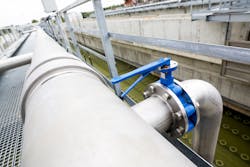Application Corner: Four flowmeters, two sewage districts
Last month’s article described the sewage collection systems for two adjacent sewage districts. Sewage from the first sewage district and the combined sewage (sewage plus drainage water) from the second sewage district are treated in a sewage treatment plant owned and operated by the second sewage district.
It would be desirable to measure the flow from each sewage district in order to appropriately allocate the cost of operating the sewage treatment plant between the two districts. The amount of sewage generated by the first sewage district can be calculated by summing the flow measurements obtained by the four sewage flowmeters. However, these four sewage flowmeters emptied into the second district’s system at different locations, so the amount of sewage produced by the second sewage district alone could not be measured.
The total plant flowmeter measured the sewage from the first sewage district plus the sewage from the second sewage district plus the co-mingled drainage water from the storm drains in the second sewage district. Sewage flow normally varies throughout the day — increasing in the morning when people wake up, decreasing somewhat during the day when people are at work, increasing in the evening when people are home and then decreasing during the overnight hours when people are sleeping.
As a practical matter, sewage systems are not completely tight, so both systems will exhibit a certain amount of inflow and infiltration (I&I) during normal operation and (more so) during wet weather events — especially in the second sewage district system that is designed to collect drainage water. Therefore, normal sewage flow variation throughout the day plus relatively large amounts of drainage water that are periodically generated by the second sewage district require that the total plant flowmeter operate over an extremely wide range of flow rates.
Read more next month about how the sewage treatment plant operating costs are allocated.
David W. Spitzer is a principal at Spitzer and Boyes, LLC, which offers engineering, focused market research, writing/editing white papers, strategic marketing consulting, distribution consulting, seminars and expert witness services for manufacturing and automation companies. Spitzer has written more than 400 technical articles and 10 books about flow measurement, instrumentation and process control. He can be reached at 845-623-1830 or via spitzerandboyes.com.
Quiz Corner
Which of the following orientations can be used to install a Coriolis mass flowmeter to measure the mass flow of a liquid in a vertical pipe flowing up?
- U-tube down
- Inverted U-tube
- Horizontal (parallel to grade)
- Flag position
Coriolis mass flowmeters in liquid service must be completely full of liquid to measure accurately. The inverted U-tube orientation (Answer B) could accumulate gas and should not be used for liquid applications.
The U-tube down orientation (Answer A) and horizontal orientation (Answer C) could be acceptable but would entail modification of the upstream and downstream piping. The flag position (Answer D) would typically be most practical.
Additional complicating factors
Not all Coriolis mass flowmeters have U-tube geometry, and some of these geometries can allow gas to accumulate in the flowmeter.
For example, a Coriolis mass flowmeter with delta-shaped tubes can accumulate gas in the downstream (upper) portion of the tubes when mounted in a flag position (Answer D), so the upstream and downstream piping should be modified to mount the flowmeter with its delta-shaped tubes down (Answer A).
Similarly, a single-path, self-filling and self-draining Coriolis mass flowmeter that forms a loop, jumps up (sideways if mounted in flag position) and then forms another loop must be installed in the horizontal plane (Answer C) to remove all gas from the system because any other orientation can allow gas to accumulate in the flowmeter.
About the Author
David W. Spitzer
David W Spitzer’s new book Global Climate Change: A Clear Explanation and Pathway to Mitigation (Amazon.com) adds to his over 500 technical articles and 10 books on flow measurement, instrumentation, process control and variable speed drives. David offers consulting services and keynote speeches, writes/edits white papers, presents seminars, and provides expert witness services at Spitzer and Boyes LLC (spitzerandboyes.com or +1.845.623.1830).
